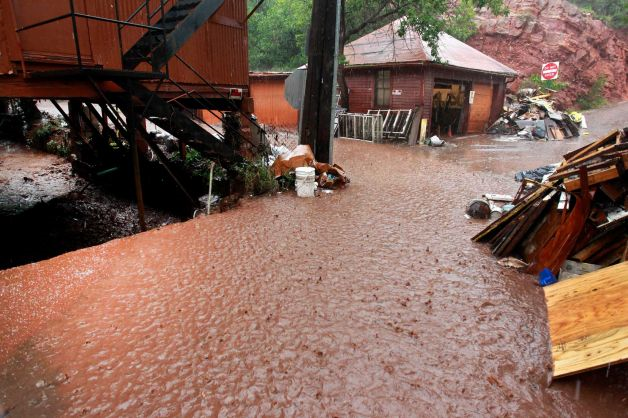First fire, then floods besiege forests in U.S. West – ‘It’s like concrete soup coming down’
By Dan Elliott, with contributions from Susan Montoya Bryan in Albuquerque, N.M., and Bob Christie in Phoenix
27 August 2013 MANITOU SPRINGS, Colorado (AP) – Drenching rain in the wildfire-blackened hills below Colorado’s Pikes Peak sent a torrent of rock and mud into the tourist town of Manitou Springs this month, killing a 53-year-old man and smashing into dozens of houses. It had been more than a year since the enormous Waldo Canyon Fire roared across the slopes above. But its burn scar is just beginning to recover, with little plant material — living or dead — to absorb this year’s late-summer rains. So when the storm came on Aug. 9, the runoff raced down, destroying or damaging 36 homes, engulfing half a dozen cars and killing John Collins, who was driving home from work. Manitou Springs was smeared with reddish mud and debris. Wildfire burn scars have spawned flash floods up and down Colorado’s Front Range and in other Western states this summer, saddling communities with millions of dollars in cleanup costs and leaving residents fearful and anxious. “I’m moving out,” Manitou Springs resident Donna Stone said after the August flood surged up against her house. “It’s incomprehensible to me that I would be safe here.” The threat lingers years after the flames have been extinguished and the human and property losses of fire have been tallied. In New Mexico, where fires have scorched more than 285 square miles of mountain slopes this year, flash floods killed fish and washed out roads in Pecos Canyon, a popular fishing area. Homes near Flagstaff, Arizona, were flooded after rainfall on an area burned in 2010. Two other floods hit in July below Arizona’s Yarnell Hill, where 19 firefighters were killed on June 30. In Colorado, multiple flash floods have struck this summer in or near scars left by last year’s Waldo Canyon and High Park fires.
The High Park Fire burned more than 136 square miles in Larimer County west of Fort Collins, killing one person and destroying nearly 260 homes. Waldo Canyon erupted days later near Colorado Springs, burning more than 28 square miles, killing two people and destroying nearly 350 homes. State officials expect to spend at least $10 million to repair flood-damaged roads and bridges in the two areas and to keep them open. Water utilities in Colorado Springs, Greeley and Fort Collins expect to spend more than $20 million — including federal grants — to repair and protect their systems in the burn areas. Manitou Springs has spent more than $130,000 on cleanup, City Administrator Jack Benson said. The city is looking into buying up to four houses in the flood area and using the land for a retention pond or some other flood control project, if funding can be found, he said. No single agency compiles the cost of erosion and floods caused by wildfires, but the U.S. Forest Service spent nearly $46 million nationwide in fiscal 2012 on emergency erosion measures. The money paid for mulch to absorb rain, shoring up roads and trails, and reseeding. Getting longer-term restoration money isn’t easy. In June, the gridlocked Congress finally approved $19 million for erosion control for Colorado’s 2012 wildfires after months of lobbying by Colorado’s Democratic senators. Rain normally is soaked up by a sponge-like layer of pine needles and twigs on the forest ground, called duff. Wildfires can incinerate that layer, and burning duff can leave a waxy residue in the top layer of soil that sheds water. A relatively light rain can rush down charred hillsides into streambeds, picking up dirt, ash, rock and tree limbs along the way. “It’s like concrete soup coming down,” said Eric Billmeyer, an instructor of geology and environmental studies at the University of Colorado-Colorado Springs. It could be a decade before all the damage plays out, said Dale Miller, road and bridge director for Larimer County. “We expect that as a result of the fire, any storm that we receive today is going to cause potentially 10 times the damage it would have before the fire,” Miller said. Denver Water, the state’s largest municipal utility, is still spending millions of dollars to stem erosion 12 years after the Hayman Fire, then Colorado’s largest ever, burned across 215 square miles in the foothills south of Denver. “It’s going to take a very long time for these areas to stabilize,” Billmeyer said. “Even with all the work that’s being done out there, really, you have to have the vegetation be restored.” [more]
First fire, then floods in besieged Western forest

